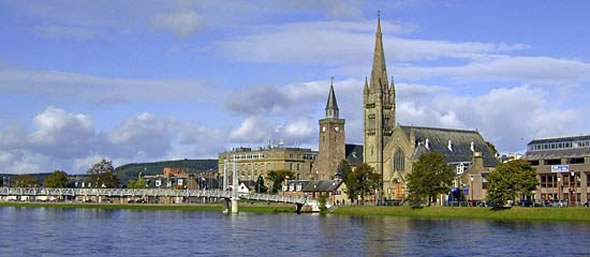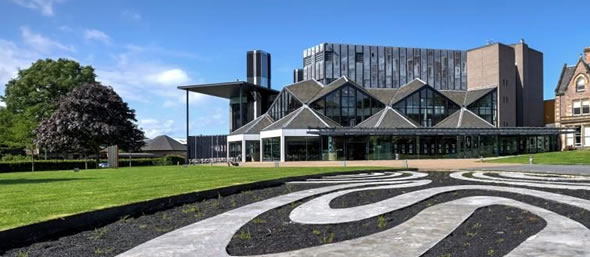Inverness Landmarks
Inverness Castle
The city is dominated by its red sandstone castle. The first fortified castle on the site dates back to the mid-12th century, the reign of King David, and would have been constructed from timber with ditches and earth ramparts, and later on it was rebuilt in stone. In the following centuries, the castle came under frequent attacks, being destroyed and rebuilt. In 1746 the castle was captured by Bonnie Prince Charlie’s army and blown up to prevent it from falling into Hanoverian hands. The present castle was built in 1834 in neo-Norman style, and is now the home of the Inverness Sheriff Court.
Statue of Flora MacDonald
On the castle terrace is a statue of Flora MacDonald who helped Bonnie Prince Charlie escape after his defeat at Culloden. In the darkness of night, she rowed him ‘over the sea’ to the Isle of Skye.
Inverness Museum and Art Gallery
Below the castle, on Castle Wynd, is the modern building of Inverness Museum and Art Gallery. The museum provides an overview of the history of the town and the wildlife of the region, while the gallery hosts special exhibitions.
Inverness Town House
Just around the corner, on High Street, is the Town House, a fine Victorian neo-Gothic Building (dating from 1883). In 1921 the first UK Cabinet meeting outside London took place here. The then Prime Minister David Lloyd George, on holiday in Gairloch, called an emergency meeting to discuss the situation in Ireland. The Inverness Formula composed at this meeting was the basis of the Anglo-Irish Treaty.
In front of the town house stands the old cross on the Clach-na-Cuddain (Stone of the tubs). In the olden times, when women had to carry water from the river, they stopped here to rest their tubs and to exchange gossip.
Opposite, on the corner of Bridge Street and Church Street, is the Tollbooth Steeple which dates from 1791. The Steeple originally adjoined the Old Court House and jail but these buildings were replaced by housing.
Abertarff House in Church Street was built around 1593 and was long the town residence of the Lovats. The house features a rare example of an old stair-tower.
Almost opposite is Dunbar’s Hospital, built in 1688 as an almshouse for the town’s poor.
Old High Church
At the end of Church Street is the Old High Church built on St Michael’s mound where St Columba of Iona is believed to have preached in the 6th century. The church was founded in the 12th century and rebuilt in 1772 but still preserves its 14th-century tower. In the yard there is a curious 17th century colonnaded enclosure.

After the battle of Culloden in 1746 the adjacent Old Gaelic Church was used to imprison the defeated Jacobite soldiers who were subsequently executed in the graveyard. You can still see the bullet marks left by the firing squads on some of the gravestones. The Old Gaelic Church is now Leakey’s Antiquarian Bookshop with a popular cafe in the top level (up the spiral staircase). It is claimed to be the largest second hand book shop in Scotland.
On the other side of the river, on Huntly Street,is Balnain House, a 1726 merchant’s house constructed in early Georgian style. After the battle of Culloden the house served as a hospital for Hanoverian soldiers. It now houses the National Trust for Scotland.
At the corner of Huntly Street and Ness Bridge, is the Kiltmaker Centre, where you can learn everything you ever wanted to know about tartan. You can see kilts being made in the factory, and could even be measured up for one of your own.
Inverness Cathedral
Almost opposite the castle, is the neo-Gothic St Andrews Cathedral which was built between 1866 and 1869. It was originally intended to have twin spires built on top of the two towers, but a shortage of building funds meant that the spires were omitted from the final construction. The font is a copy of Thorwalden’s font in Copenhagen, and there are Russian gold icons. Concerts and organ recitals are held here.
Eden Court Theatre
Close by is the recently refurbished and extended Eden Court Theatre. With its two theatres and two cinemas it offers a wide variety of entertainment and exhibitions throughout the year.

The Ness Islands
Continuing south along Ness Bank, you reach Bught Park and Whin Park, joined by footbridge to both banks. The islands are attractively laid out. This is a lovely place for an evening stroll if you want to find peace and tranquility.
Farmers’ Market
Inverness has a great variety of eating places offering the best of Scottish food or international cuisine (including Indian, Chinese, French, Italian and Spanish). Hotel bars and pubs have a fine selection of single malts and locally produced ales. Many pubs offer life entertainment anything from folk music to rock.
Victorian Market
There are many small shops in the indoor Victorian Market. The modern Eastgate Shopping Mall is at the top end of the pedestrianised main street and entertainment often takes place in front of it, in Falcon Square.
